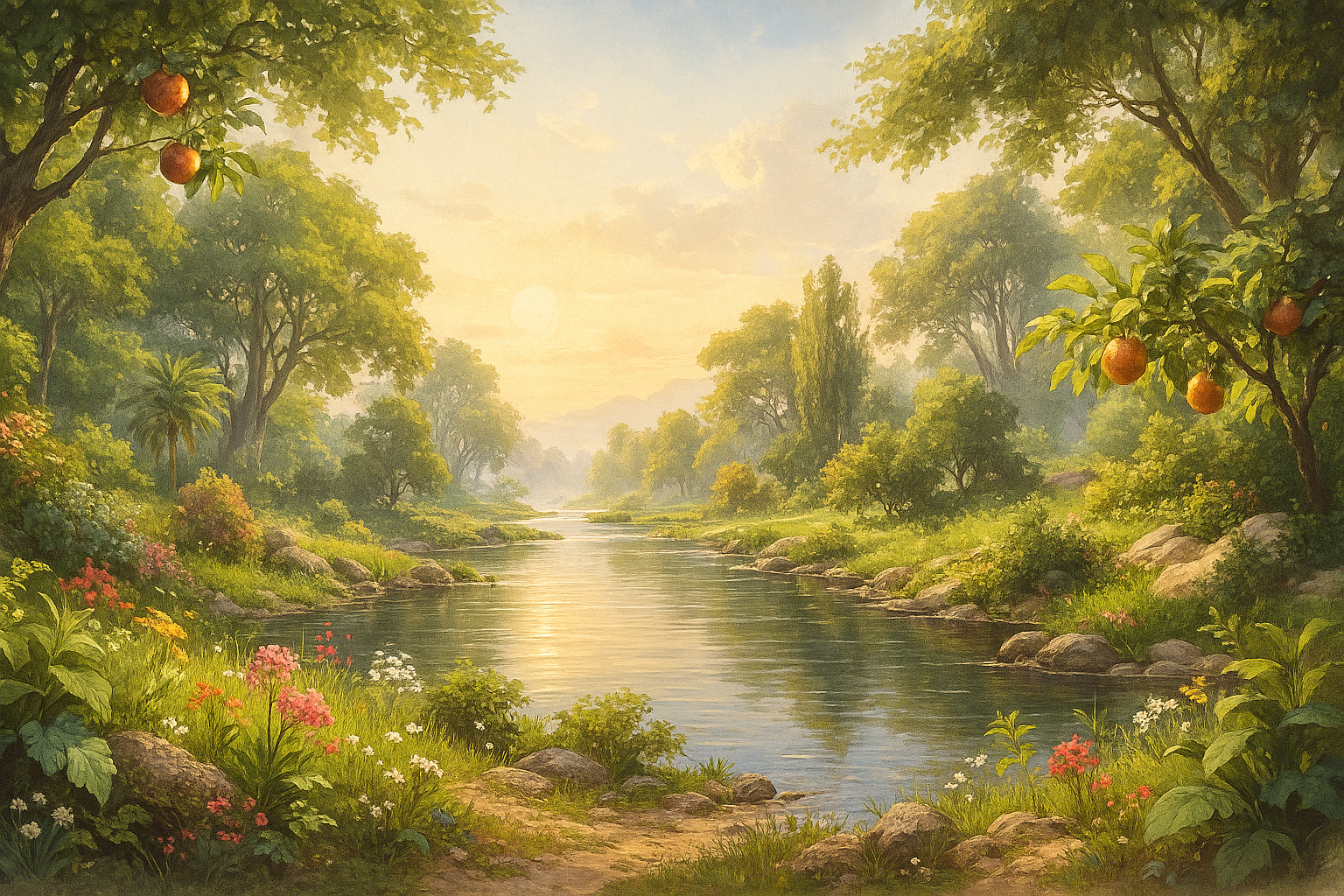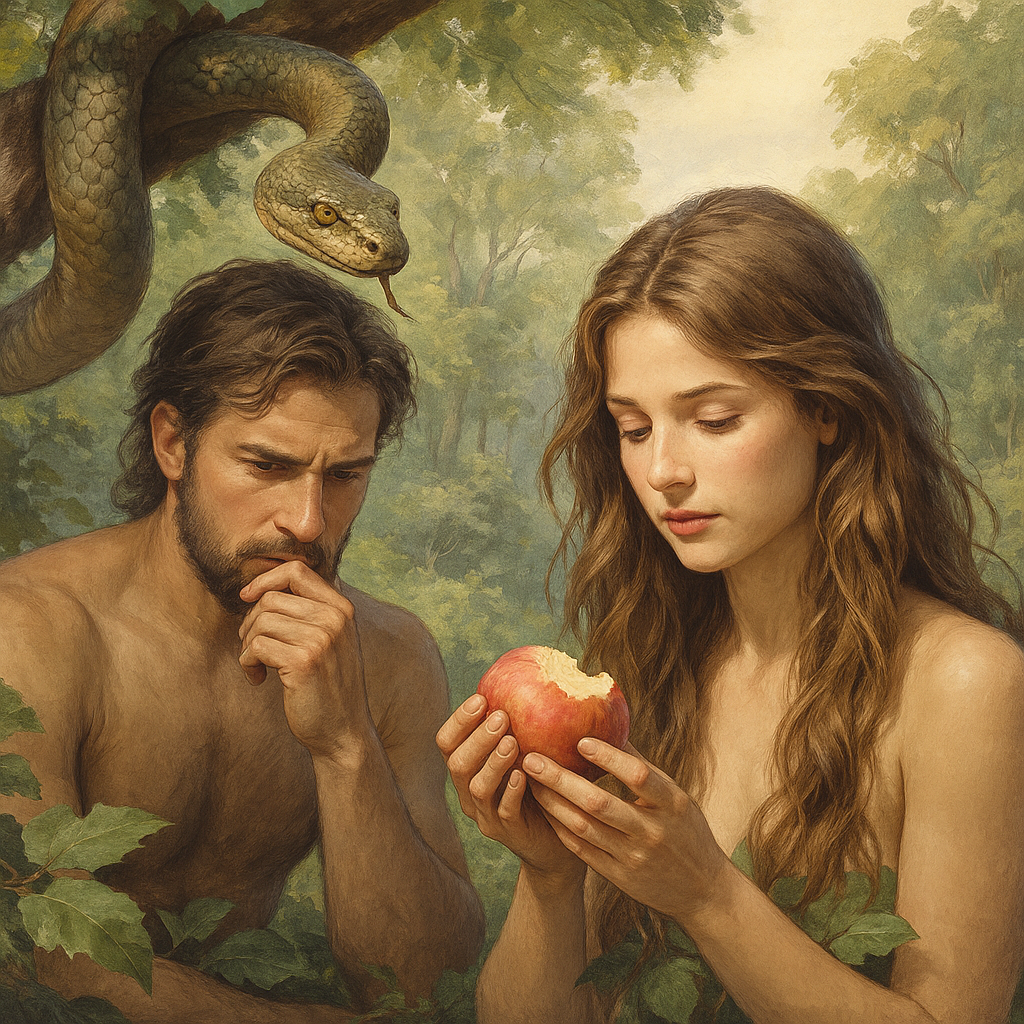Where Did Sin Come From?
Why Is the World So Beautiful but Also So Broken?
Lush early-morning light over a perfect garden — calm waters, fruit trees, radiant peace
Have you ever looked at this world and felt two things at once — wonder and sadness?
A sunset that makes you want to worship, yet headlines that make you want to weep.
How can one world be so beautiful… and yet so broken?
The answer is found in the first few chapters of Genesis — not as an old myth, but as the truest story of how everything went wrong, and how God began making it right.
The Garden of Perfection
Everything God made was good — pure, alive, whole.
“God saw all that He had made, and it was very good indeed.” — Genesis 1:31
Adam and Eve lived in perfect peace with God. They had meaningful work, deep joy, and unhindered love. God was not distant — He walked with them.
Eden was filled with freedom:
“You are free to eat from any tree in the garden,” God said, “but you must not eat from the tree of the knowledge of good and evil.” (Genesis 2:16–17)
It was one boundary in a world full of yeses — a loving reminder that life depends on trust.
God’s command wasn’t harsh; it was the safety rail of love.
A serpent glimmering among tree branches as soft light filters through — beauty and danger intertwined
The Serpent’s Deception
Another voice entered the garden — the serpent, “more cunning than any of the wild animals the LORD God had made.” (Genesis 3:1)
This was Satan in disguise, the fallen angel who once rebelled against God and now sought to corrupt what God loved most: His image-bearers.
His strategy was subtle: not denial but distortion.
“Did God really say…?” he whispered — planting doubt where there had been delight.
He made God’s love sound like control, His command like limitation.
Eve looked at the fruit — “pleasing to the eye and desirable for gaining wisdom.” (Genesis 3:6)
She wanted what she thought would make her more like God — forgetting she already bore His image.
The lie of the serpent is always this: “You can find life apart from the One who gave it.”
Adam and Eve reaching toward the forbidden tree, light and shadow dividing the scene
The Choice and the Blame
Eve took the fruit and ate, and Adam — standing beside her — chose to eat as well.
He wasn’t deceived; he made a decision.
He followed Eve instead of leading her, turning away from God’s word.
At once, they felt the chill of separation.
“Then the eyes of both of them were opened, and they knew they were naked.” — Genesis 3:7
Shame replaced innocence; fear replaced peace.
When God called, “Where are you?” it was the voice of a Father seeking His lost children.
Adam answered, “The woman You gave me — she gave me the fruit.” (Genesis 3:12)
In blaming Eve, he blamed God.
Sin fractures not only our relationship with God but also our relationships with one another.
A sorrowful couple leaving a radiant garden gate; soft light falls on new garments of animal skin
The Consequence and the Mercy
God’s judgment wasn’t cruelty — it was love telling the truth.
If humanity had stayed in Eden while separated from God, we would have lived forever in a broken state.
So God sent them out — not to destroy them, but to begin redemption.
And even as He did, He showed mercy:
“The LORD God made garments of skin for Adam and his wife, and clothed them.” — Genesis 3:21
The first death in Scripture covered human shame — a shadow of the cross to come.
And to the serpent, God gave a promise:
“He will strike your head, and you will strike his heel.” — Genesis 3:15
The first prophecy of Jesus, the Savior who would one day crush evil completely.
Wildflowers growing through cracked earth; sunlight and storm clouds in the same sky
The Beautiful and the Broken
When Adam and Eve left Eden, beauty remained — but now it shared space with pain.
Roses bloomed, but with thorns.
Work mattered, but became toil.
Love endured, but now required grace.
Our hearts remember the garden even though we’ve never been there.
That longing for peace, goodness, and home is the echo of Eden inside us.
“All creation has been groaning together with labor pains until now.” — Romans 8:22
The ache you feel when things go wrong isn’t disbelief — it’s homesickness for what once was, and hope for what will be again.
The Promise Fulfilled in Jesus
Thousands of years later, another Man entered another garden.
He didn’t hide from God — He prayed, “Not My will, but Yours be done.” — Luke 22:42
In Eden, humanity said “no” to God’s command.
In Gethsemane, Jesus said “yes” to God’s plan.
On the cross, He became our covering — not with animal skin, but with His own blood.
He crushed the serpent’s head by taking the sting of sin into Himself.
The story that began in a garden of disobedience found redemption in a garden of surrender.
Because of Jesus, what was lost in Eden can be restored in us.
The gates that once closed are opening again — and one day, the story will end where it began:
“The dwelling of God is with humanity.” — Revelation 21:3
Reflect and Remember
The world is beautiful because God made it, and broken because we rebelled.
Yet even in our failure, God never stopped loving us.
Read Genesis 3 this week.
Notice how God still speaks, still seeks, still clothes.
Then thank Jesus, who came to open the way back to the Father.
The same God who called, “Where are you?” in Eden
is calling you today — not to condemn, but to bring you home.
Teaching Outline: “Where Did Sin Come From?”
Why Is the World So Beautiful but Also So Broken?
Introduction
• The world around us reveals both breathtaking beauty and heartbreaking brokenness.
• Every person feels that tension — joy mixed with sorrow, wonder shadowed by pain.
• The Bible tells us why: sin entered a perfect world, distorting what God made good.
• Today we’ll trace that story from creation to the Fall, and glimpse the hope of redemption through Jesus.
I. The Garden of Perfection — God’s Good Creation
Everything God made was good.
“God saw all that He had made, and it was very good indeed.” — Genesis 1:31Creation reflected God’s goodness, wisdom, and order.
Humanity was made to walk in peace with God, one another, and creation.
God gave one loving command.
“You are free to eat from any tree in the garden, but you must not eat from the tree of the knowledge of good and evil.” — Genesis 2:16–17This boundary was not a restriction, but a protection — a reminder that life depends on trust.
True love must allow choice; obedience is love expressed through trust.
II. The Serpent’s Deception — How Sin Entered the Story
The serpent was more cunning than any creature.
“Did God really say…?” — Genesis 3:1The serpent was Satan speaking through a creature God had made.
His goal was not to make Eve hate God, but to doubt Him.
The lie beneath the temptation.
“You will be like God, knowing good and evil.” — Genesis 3:5The serpent promised wisdom apart from God — the same pride that caused his fall.
Eve desired what seemed good, forgetting she already bore God’s image.
The temptation wasn’t about fruit; it was about trust and authority.
III. The Choice and the Blame — Humanity’s Fall
Adam and Eve chose to disobey.
“She took some of its fruit and ate it; she also gave some to her husband, who was with her, and he ate it.” — Genesis 3:6Eve was deceived, but Adam chose willfully.
In that act, humanity turned from dependence to self-rule.
The first effects of sin.
“Then the eyes of both of them were opened, and they knew they were naked.” — Genesis 3:7Shame replaced innocence; fear replaced peace.
They hid from the very One who had given them life.
The first blame-shifting in Scripture.
“The woman You gave me — she gave me some fruit from the tree, and I ate.” — Genesis 3:12Adam blamed both Eve and God.
Sin fractures relationships — first with God, then with others.
IV. The Consequence and the Mercy — God’s Response
God’s judgment revealed His holiness and justice.
“Because you have done this… you are cursed.” — Genesis 3:14Sin cannot coexist with a holy God.
God’s discipline was not cruelty, but love, a telling of the truth.
Even in judgment, mercy appeared.
“The LORD God made garments of skin for Adam and his wife, and clothed them.” — Genesis 3:21God covered their shame with sacrifice — the first hint of redemption through blood.
The first death in Scripture prefigured the Cross.
The promise of victory over evil.
“He will strike your head, and you will strike his heel.” — Genesis 3:15The earliest prophecy of Christ, the offspring of the woman who would crush the serpent’s power.
God’s rescue plan began before humanity left the garden.
V. The Beautiful and the Broken — Living in a Fallen World
The world still bears both beauty and pain.
“All creation has been groaning together with labor pains until now.” — Romans 8:22Thorns grew on roses; toil replaced ease.
Yet beauty remains — every sunrise and act of kindness whispers of Eden.
Our longing for goodness is holy homesickness.
We ache for a world that once was — and will be again.
That longing is the Spirit’s reminder that redemption is on the way.
VI. The Promise Fulfilled in Jesus — Redemption’s Beginning
Jesus reversed the curse.
“Not My will, but Yours be done.” — Luke 22:42In Eden, man said “no” to God’s will.
In Gethsemane, Jesus said “yes” on our behalf.
The cross became our covering.
God once clothed Adam and Eve with skins; now He clothes us in righteousness.
“For just as in Adam all die, so also in Christ all will be made alive.” — 1 Corinthians 15:22
The garden story comes full circle.
“The dwelling of God is with humanity.” — Revelation 21:3The Bible begins in a garden and ends in one — with no more curse, no more shame.
What was lost in Adam is restored in Christ.
Reflection and Application
• Where do you see both beauty and brokenness in your life right now?
• What lies has the enemy whispered to make you doubt God’s goodness?
• How does the cross prove that God never stopped loving us, even in our rebellion?
• Close with prayer: gratitude for His mercy and hope for restoration.





